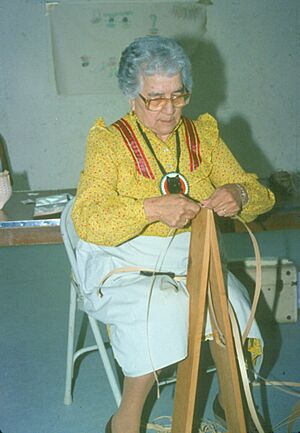Mary Kawennatakie Adams facts for kids
Mary Kawennatakie Adams (born January 24, 1917 – died May 23, 1999) was a talented Mohawk artist. She was famous for making beautiful baskets and other textile art. She was a member of the First Nations people in Canada.
Contents
Early Life and Background
Mary Kawennatakie Adams was born on Cornwall Island. This island is part of the Akwesasne community. Akwesasne is a Mohawk Nation territory. It is located near the border between New York and Canada. Mary was born in Ontario, Canada. Her Mohawk name, Kawennatakie, means "approaching voice."
Mary did not go to school after she was 16 years old. She also did not learn to speak English until she was an adult.
Learning to Make Baskets
Mary spent her childhood with her mother and grandmother. When she was only 6 years old, her mother taught her how to make baskets. She learned to prepare materials like black ash wood and sweetgrass. Then she learned how to weave them into baskets.
When Mary was 10, her mother passed away. Her father left the reserve to find work as an iron worker. Mary started trading her baskets locally. She traded them for food and other things her family needed. Later, she found out that trading baskets for cigarettes, and then selling the cigarettes, earned more money. This way, she was able to support herself and her brother. Her brother helped her by cutting down the ash trees. This made it easier for her to prepare the wood.
Supporting Her Family
Mary got married when she was 17. She had 12 children. She supported her large family by making baskets. Everyone in her family helped with the basket-making process. They helped with cutting, pounding, cleaning, shaving, and braiding the materials. By the time she was in her early 50s, she was financially independent. This meant she could make more creative and unique baskets. Before, she mostly made useful, everyday baskets.
Later in her life, Mary taught others how to make baskets. She taught on the Mohawk Reserve at Akwesasne. She also traveled a lot to show people how Mohawk baskets were made. Mary's baskets often showed her mixed background. She was both Mohawk and Roman Catholic. A scholar named Olivia Thornburn said this mix was "interwoven with her splint ash and sweet grass baskets." Mary was also very active in her church, St. Regis Catholic Church.
Another scholar, Sherry Farrell Racette, noted Mary's amazing skill. She was very good at a special stitch called the "bird-mouth" stitch. She also created interesting textures. She did this by adding tiny, miniature baskets to her larger ones.
The Pope Basket
In 1980, Mary Adams made a special basket for Pope John Paul II. She gave it to him at the Vatican. This basket honored the beatification of Kateri Tekakwitha. Kateri Tekakwitha was a famous Mohawk-Algonquian woman from the 1600s.
The design of this basket, called the Pope Basket, was very grand. It was described as "highly architectural and almost baroque." The lid of the basket might have looked like the Pope's small cap, called a zucchetto. The shape of the basket was also similar to the large dome of St. Peter's Basilica. Mary said the idea for this special basket came to her in a dream. A copy of the basket, also made by Mary, is kept at the Smithsonian museum.
Achievements and Legacy
During her life, Mary Adams made more than 25,000 baskets! In 1997, she received an award for her excellent Iroquois art. This award came from the Iroquois Indian Museum. Mary's work was also shown in a 1998 art exhibition. It was called Crossing the Threshold and featured women artists.
Family Life
Mary Adams married Michael Adams on September 18, 1939. They had twelve children together.
Where Her Art Is Kept
Mary Adams's baskets are in many important art collections. You can find her work at:
- The Iroquois Indian Museum in New York
- The Thunder Bay Art Gallery
- The New York State Governor's Collection of Art in Albany
- The Smithsonian American Art Museum
Exhibitions of Her Work
Her baskets have been shown in many famous places, including:
- The Smithsonian Institution
- The Museum at the University at Albany, SUNY
- The Heard Museum
- The National Museum of the American Indian
- The Pitt Rivers Museum
- The Minneapolis Institute of Art
Later Life and Passing
Mary Adams continued to make baskets throughout her life. Even when her eyesight started to fail, she kept working. She was braiding sweetgrass for her daughter Trudy, who also made baskets. Mary Adams passed away at home on May 23, 1999. She was in Snye, Quebec, on the Akwesasne Mohawk Reserve.
See also
 In Spanish: Mary Kawennatakie Adams para niños
In Spanish: Mary Kawennatakie Adams para niños


